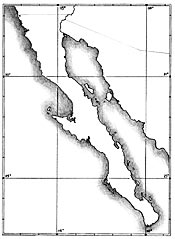![[Ocean Oasis Field Guide]](images/bnr-oo-field.gif)

![[Ocean Oasis Field Guide]](images/bnr-oo-field.gif) |  |

Anyone interested in Baja California soon discovers that the same region or locality may be called by different names at different times, by different people, or on different maps. Sometimes this reflects the languages of the speakers—Spanish, English, and indigenous Indian languages. Sometimes it's a result of historical and political changes in what certain areas are called. And sometimes it might even be a result of misspellings or mispronunciations being passed down through time. While we've tried to be consistent within any section of this site, it hasn't been possible to choose one "authoritative" usage throughout—because even the authorities disagree! Certainly the writers of the different sections do. Below is an attempt to sort out some of the names. The Peninsula of Baja California
In the oldest European history of the region—when most of western North America was part of the Spanish colony of Mexico, and the peninsula to the west had just been discovered and was little explored—the name "California" was applied to all of the peninsula and what is now the state of California in the United States. At some point this large region was divided into Alta (Upper) California—the continental portion which became the state of California, and Baja (Lower) California—the peninsular portion which remained as part of Mexico.
Things became more complicated when the peninsular portion was divided at the 28th parallel into a northern state called Baja California, and a southern territory, Baja California Sur—later to become a state as well. The correct name of the northern state is "Baja California," not "Baja California Norte." The easiest analogy for Americans is that it's like the names of Virginia and West Virginia. No state of East Virginia was created when Virginia was divided.
The problem, of course, is that if the northern state is called "Baja California," then what do we call the whole peninsula with two Mexican states? If a scientific report refers to "the plants of Baja California," does it mean of the whole peninsula or only half of it? And if you say "peninsula," does that include the nearby islands?
It's best to be explicit: "the State of Baja California," "the Baja California peninsula." Some prefer the old-fashioned "Lower California" as clearly referring to the peninsula and its islands, and not to the state. Incidentally, using "Baja" alone raises eyebrows as being the ungrammatical use of an adjective as if it were a noun (for example, one wouldn't refer to New York as just "New").
The Binational Geological Region
Ignoring the political boundaries, another problem is trying to find a name for the geological unit to the west of the San Andreas faultline. "Peninsular California" is one solution; somewhat less satisfactory is "greater Baja California."
The Gulf and its Islands
The body of water that separates the peninsula from mainland Mexico has two names, and both are used in both English and Spanish.
One is "Gulf of California," or "Golfo de California." The other is "Sea of Cortés," or "Mar de Cortés." Scholars tell us that the name of the explorer for whom the sea is named is correctly spelled with an "s" rather than a "z" (that is, "Cortez" is a historic misspelling).
It's also important to be aware that most of the islands in the Gulf have been known over the years by more than one name—so that for example, if you see a reference in different sources to a species being found only on a particular island, but the references name different islands, it may simply be that they're using two different names for the same island. The only solution to this problem is a list of synonyms.
Judy Gibson, Botany Department, SDNHM |
Field Guide |
Site Index |
Ocean Oasis Introduction
|
|
© 2000 San Diego Natural History Museum |